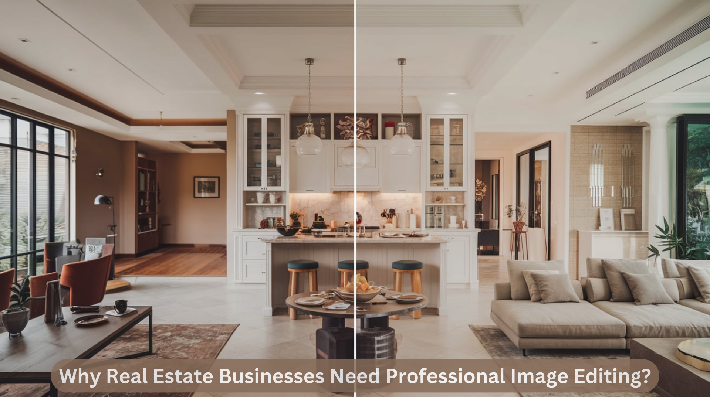
Why Should Real Estate Businesses Not Overlook Image Editing?
Browsing through social media sites like Instagram, we often stop at some posts/reels and skip others. Why? Because some photos or videos appeal to the eye. They make us want to check out that content. When posting real estate properties online, the same concept applies.
As a seller, broker, or realtor- as practically anybody who wishes to sell a property online -you must understand this formula: presentation matters. To reel in a potential consumer who’d choose to buy or rent a house, you need to make them curious about the property, make them want to explore it more, and maybe visit it. That journey starts with a listing containing clear and stunning property photos, video tours, interior and exterior photos, etc. All in good quality.
Therefore, you need to focus on real estate photo retouching!
Table of Content
- 1 How Does Real Estate Image Editing Make a Difference in Selling Properties?
- 2 What Needs to be Done in Property Photo Retouching?
- 2.1 1. Color Correction: Making Colors Pop and Look Real
- 2.2 2. Solving Inconsistent Lighting Problems by Balancing Exposure
- 2.3 3. Virtual Staging: To Show the True Potential of the Property to the Buyer
- 2.4 4. Perspective Correction, So the Building and Rooms Look Just Right
- 2.5 5. Highlighting Architectural Detail to Show off a Property’s Unique Selling Proposition
- 2.6 6. HDR Blending: For Impressive Property Photos
- 2.7 7. Seasonal Adaptations: So a Buyer Knows What to Expect from the Property All Year
- 2.8 8. Panoramic Property Photos and 360-Degree Property Videos
- 3 Now, the Most Important Question
- 4 Do You Have Time for Real Estate Photo Editing?
- 5 So, What Can You Do? Outsource Real Estate Image Editing Services
How Does Real Estate Image Editing Make a Difference in Selling Properties?
1. High-Quality Real Estate Images Help Properties Stand Out
The market is crowded. Competition is always high. In this case, if you want to sell a property, you must outshine other sellers. How will you do that? With images that can make your listings pop! With professionally edited photos, you can-
- Fix issues with lighting
- Enhance image colors
- Remove any unwanted elements from the property photos
- Make the area look cleaner and better overall
2. Image Editing Saves Time and Money
You may think- why not just take better photos?
The thing is, how will you do that if the weather is dull, or the photographer only has 30 minutes to shoot the property, or the lights inside are so weirdly set that each photo comes out dark?
Then there are other things, like technical limitations, issues with lenses, issues with exposures, etc. It is not always possible to control the circumstances in which a property shoot takes place. But using professional photo editing techniques later can save you the time and cost involved in scheduling a reshoot.
3. Property Photo Editing Can Improve Your Market Reputation
Out of all the home buyers who chose to explore properties using the internet, 41% considered photos to be the most valuable content on the website. Second position for the most valuable content went to detailed property information (39% votes) and the third to floor plans (31% votes).
What does this statistic from the National Association of Realtors tell you?
It should tell you that the potential real estate customers are hungry for information. They want to see how the property looks inside and out, what it contains, what problems it has, how the structure looks, what potential it has (if they want to remodel), and so on. Give them this information (the more visual, the better) and they will trust you. If they trust you, they will enquire, leave a lead, want to visit the property.
Isn’t that the ROI every realtor needs from the online listings they put up!
What Needs to be Done in Property Photo Retouching?
1. Color Correction: Making Colors Pop and Look Real
Nobody wants to see yellow-tinted indoor shots or grayish outdoor photos that look washed out. Good real estate photo editing includes:
- White balance adjustment to remove weird color tints that make rooms look unnatural
- Vibrance enhancement to bring dull colors back to life (like making green lawns look lush or ensuring photos of wooden floors maintain the shine)
- Color temperature correction, like ensuring warm and cool tones appear real or natural light coming into rooms is captured well in photos
2. Solving Inconsistent Lighting Problems by Balancing Exposure
Ever noticed how photos of some rooms look too dark (like caves) or windows just appear like massive white blobs? This happens because there is shadow and light in real life, but in photography, they get treated as areas of brightness and darkness. Now, if your camera has a limited dynamic range (which is usually what happens), it will not capture the details properly in too bright or too dark areas. Hence, the white blobs or dark caves!
Professional photo editing techniques can help:
- Capture lighting evenly across the entire image
- Capture adequate details in both sunny and shadowy spots
- Bring out details in darker areas that are otherwise hidden due to low light
- Show texture in carpets, furniture, and wall surfaces
- Prevent windows from looking like bright white rectangles
- Show outdoor views clearly
- Maintain natural light without burning out the image
Exposure balancing helps potential buyers see every corner of the room. It makes the spaces look larger and more welcoming, and it also helps the buyer appreciate the property with its natural lighting.
3. Virtual Staging: To Show the True Potential of the Property to the Buyer
It is time-taking, not to mention expensive, to stage a property.
For instance, if the place is already rented out, and the existing tenant has their stuff in it, but you want to showcase the place stripped of all furniture, or you want to showcase it decorated in a specific style that you think will attract more buyers, how will you do it?
The traditional way is to remove old furniture, rent and stage new furniture, schedule a photoshoot, take photos, then return the new furniture. Lots of hassle, lots of time involved, and of course, the cost of renting and transport and so on.
Virtual staging is an easier and better way to do this, to help prospective buyers visualize the potential a place can hold. With this professional photo editing technique, you can:
- Places realistic-looking virtual furniture in empty rooms
- Show potential room layouts
- Help buyers visualize the room’s scale
- Show how a room could look in different interior decor styles
- Show remodeling potential for the property
4. Perspective Correction, So the Building and Rooms Look Just Right
Take a photo of any stationary object (preferably of the same height as you are) with the camera at your chest-height, or while squatting down and keeping the camera at ground level, or by holding the camera above your head. The results are so different! The object you shot will look proportional to its real dimensions in the first photo. It will look unnaturally larger in the second shot. It is likely to look smaller than it is in the third shot.
This difference in how the object appears depending on the angle at which it is shot is what we call perspective distortion.
Some types of perspective distortions also occur because of the lens a photographer is using. For example, if you use wide-angle lens, the straight borders of wall or windows will look warped.
Fixing these is important, because you don’t want a buyer to think- “That hallway looks too long. Is that even real?” or “That room seems fine but the windows are slightly curved. This photo is likely trying to cheat me.”
Perspective correction allows you to correct camera lens tricks and create high-quality real estate images that:
- Show true room size and shape
- Help buyers trust what they’re seeing
5. Highlighting Architectural Detail to Show off a Property’s Unique Selling Proposition
Some properties come with unique features. Like, a Victorian style staircase, a skylight in the hall, a rustic vintage fireplace, a green roof, solar panels, or sculptures in the lawn- you get the idea.
Highlighting these architectural features can help increase the property’s market value. But, first, you must edit them in real estate photos to:
- Increase image contrast
- Sharpen fine details
- Bring out texture
- Highlight special design elements
6. HDR Blending: For Impressive Property Photos
Let’s say you wish to showcase the view outside a window, and at the same time, in the same photo, you want to highlight how the natural lighting illuminates the room.
The problem here is that no camera can effectively capture different levels of brightness in a single photo.
- If you try to focus on the view outside the window, the rest of the room will appear dark.
- If you focus on the insides of the room, the window will appear too bright, with no details.
HDR (High Dynamic Range) blending is a professional photo editing technique that can solve this problem. What happens is this- a photographer takes multiple photos of the same room. The photos are shot at different exposure levels (like, one focusing on the window, another on the inside of the room). Then, these photos are blended, and the exposure (brightness level) is manually adjusted when retouching the real estate photos.
As a result, you can create high-quality real estate images with equal focus on every part of the room, preserving all the details, and showcasing the room in its best image.
7. Seasonal Adaptations: So a Buyer Knows What to Expect from the Property All Year
Can you wait to shoot real estate photos in summer, winters, spring, and fall, and then post a listing? Does it make sense to invest into four separate photoshoots and wait a whole year before posting one listing?
No, right! It is unimaginable to think how the ROI will be hit, not to mention the added cost of four photoshoots and photographer payments. It is all losses!
But, would it not impact your sales positively if you could show how the property looks like across the seasons, throughout the year? Well, an easier way to do that is through real estate photo editing. You can make a property look well-maintained and increase the potential of sales by retouching details like:
- Replace brown grass with green grass for summer views
- Replace dull skies with bright sun-lit skies or dawn or dusk views
- Remove snow from property exteriors (if shooting during winters)
- Enhance landscape colors to match different seasons
- Create consistent lighting as per the season you want to portray
8. Panoramic Property Photos and 360-Degree Property Videos
Aerial photos are currently the most popular real estate marketing trend. Realtors hire drones to shoot a property from up above and also to create walkthrough videos. It gives the buyer a closer idea of the space (inside and outside) without the need to visit it. It is engaging, sparks curiosity among potential buyers, and leads to higher inquiries too.
But, investing in drone photography might not be every realtor’s cup of tea. So, the next alternative is shooting panoramas and normal photographs and stitching them into a 360-degree photo or a property tour. This way, you can show the entire property layout in sufficient detail.
Now, the Most Important Question
Do You Have Time for Real Estate Photo Editing?
I am sure you now understand the impact of edited images on real estate marketing and sales campaigns. But, if you or your team were to sit down and retouch property photos, how justified is that investment?
- Are you okay with spending time learning photo editing skills and tools?
- Can you afford to take your focus away from other core tasks?
- What about the cost of subscribing to premium photo editing software?
- Even if you hire professionals, say a small team of real estate photo editors, does the expense of their full-time salaries and benefits make sense to your business plan?
Because it may. And it may not!
For example, If you manage over a thousand property listings each month, it makes sense to hire a dedicated team and let them handle real estate photo retouching. But even then, if your load is not consistent, if more photo editing is needed during one period and less during the other, hiring a full-time team will become more costly and less beneficial.
So, What Can You Do? Outsource Real Estate Image Editing Services
Hire a team of real estate image editors without the burden of managing them, or paying them full-time, or even handling their workload. Outsourcing saves you time, money, and stress. It is certainly cheaper than hiring full-time photo editors and you only pay for the work you need. The delivery times are usually quick (12-24 hours in most cases with reputed real estate photo editing companies).
Just remember this- If you choose to outsource property photo editing, research well. You must have all the information about the service provider, their service terms and conditions, and their portfolio. Check out their previous work. Get a photo editing sample (many provide this for free) and then judge their work against your expectations to make the right call.
About Author
Brown Walsh is a content analyst, currently associated with SunTec India- a leading multi-process IT outsourcing company. Over a ten-year-long career, Walsh has contributed to the success of startups, SMEs, and enterprises by creating informative and rich content around data-specific & photo editing topics, like data annotation, data processing, data mining and real estate image editing. Walsh also likes keeping up with the latest advancements and market trends and sharing the same with his readers.


